There's some interesting bits here and there !
i think, for the vast majority of us, this is still way too complicated ; maybe for a profesional cactus grower wanting to truly optimize his genetics ?
Even though, i like these ideas - i think it rises broader issues. As with weed, we might to "optimize" mescaline content (or thc), to realize there are other interesting synergetic alkaloids at play, ... and eventually going full circle, re inventing nature diversity. But meanwhile, we favored centralize, bigger scale operations... rather than just the mysterious infinite diversity of little cactus growers over the world (i like that the cactus didn't went mainstream, and mostly not codified nor labeled with names and brands and quantitative %... )
But yet ! i would love an easy, low tech way of roughtly judging the potency of a brew... while i like the unknown, for dosing first timer it's sometime too random...
Inspired by their work, would there be a way ?
the most intesting data for me, was the variation of mescaline within one specimen! apparently, they can be much stronger by the top !
(which then, make you think , while harvesting, to maybe choose to cook the top, while rerooting the middle cut ? )


